 A genuine four-seater Ferrari, the all-aluminium 612 Scaglietti is
the result of an avant-garde design that guarantees the pure, thoroughbred
performance demanded by Ferraristi combined with uncompromising driver
and passenger comfort. The new 2+2 model signals a genuine break with
the past. Ferrari has changed the rules of the game with the 612 Scaglietti
to suit the tastes and needs of a highly sophisticated clientele which
now demands elegance and dynamic comfort as well as blistering performance.
The 612 Scaglietti is very much a third millennium product, offering
a whole new generation of technologies compared to the 2+2 it replaces.
In fact, it isn't really a 2+2 at all but more a genuine roomy two-door
four-seater that offers its occupants a comfortable, pleasant ride
in any driving conditions.
A genuine four-seater Ferrari, the all-aluminium 612 Scaglietti is
the result of an avant-garde design that guarantees the pure, thoroughbred
performance demanded by Ferraristi combined with uncompromising driver
and passenger comfort. The new 2+2 model signals a genuine break with
the past. Ferrari has changed the rules of the game with the 612 Scaglietti
to suit the tastes and needs of a highly sophisticated clientele which
now demands elegance and dynamic comfort as well as blistering performance.
The 612 Scaglietti is very much a third millennium product, offering
a whole new generation of technologies compared to the 2+2 it replaces.
In fact, it isn't really a 2+2 at all but more a genuine roomy two-door
four-seater that offers its occupants a comfortable, pleasant ride
in any driving conditions.
 Grand Tourers are a real Ferrari tradition: the Prancing Horse marque built its first 12-cylinder 2+2 in 1948 (the 166 Inter, bodied by Touring), and then added other famous models clothed by such celebrated names as Ghia, Pinin Farina, and Vignale. These included the 212 Inter (1951), the 250 GT (1960), the 330 GT (1964), and the 365 GT (1967) which, for the very first time, boasted an automatic gearbox on some of the examples built for the American market, right up until the 456M of the 1990s. Grand Tourers are a real Ferrari tradition: the Prancing Horse marque built its first 12-cylinder 2+2 in 1948 (the 166 Inter, bodied by Touring), and then added other famous models clothed by such celebrated names as Ghia, Pinin Farina, and Vignale. These included the 212 Inter (1951), the 250 GT (1960), the 330 GT (1964), and the 365 GT (1967) which, for the very first time, boasted an automatic gearbox on some of the examples built for the American market, right up until the 456M of the 1990s.
The new model, skilfully designed by Pininfarina to clothe the engineers' technical and functional solutions in an aggressive yet elegant body, was named by Luca di Montezemolo in honour of Sergio Scaglietti, the Modenese stylist and coachbuilder who excelled in sculpting aluminium. In fact, Scaglietti was responsible for bodying some of the most beautiful Ferraris of the 1950s and 60s. The 6 of the 612 indicates the car's displacement (5,748 cc rounded off), while 12 is the number of cylinders boasted by the engine.
 The concept that inspired the new design (coded F 137) sums up Ferrari's talent for innovation: it has done nothing short of marrying a cabin capable of accommodating four occupants in comfort with the body of a thrillingly nimble sporty front-engined rear-wheel drive berlinetta, offering unprecedented onboard comfort and specification. The concept that inspired the new design (coded F 137) sums up Ferrari's talent for innovation: it has done nothing short of marrying a cabin capable of accommodating four occupants in comfort with the body of a thrillingly nimble sporty front-engined rear-wheel drive berlinetta, offering unprecedented onboard comfort and specification.
This is a car with all of the fiery temperament and driving pleasure of a thoroughbred Ferrari, combining thrilling performance, agility and safety. But it also goes a step further, offering rear passengers two comfortable, roomy seats.
The aluminium technology used in the space frame chassis and bodywork, which proved such a success for the 360 Modena, results in a massive 60% increase in overall bodywork efficiency (weight-rigidity ratio). The light yet incredibly rigid aluminium construction also offers other significant benefits in terms of performance (acceleration, braking efficiency, handling, dynamics, and general drivability), comfort (wonderfully silent) and safety. In fact, the 612 Scaglietti's robust structure and restraint systems guarantee maximum occupant protection in the event of a collision.
 The second design choice to influence the 612 Scaglietti's styling was its architecture. A mid-front layout with the engine mounted behind the front axle, and the gearbox and differential in unit at the rear ensure that the centre of gravity is kept as far back and as low as possible. Other significant masses (the cabin, cooling and exhaust systems, the battery, fuel tank) are also positioned much further back than in a conventional layout. The second design choice to influence the 612 Scaglietti's styling was its architecture. A mid-front layout with the engine mounted behind the front axle, and the gearbox and differential in unit at the rear ensure that the centre of gravity is kept as far back and as low as possible. Other significant masses (the cabin, cooling and exhaust systems, the battery, fuel tank) are also positioned much further back than in a conventional layout.
These solutions, combined with an all-aluminium structure which lightens the entire car, deliver a centre of gravity that is considerably lower and further back plus near-perfect weight distribution (46% front, 54% rear). A particularly impressive achievement in a front-engined four-seater.
 The 612 Scaglietti offers the kind of dynamic performance (0-100 km/h sprint in just 4.2 seconds), stability and nimble manoeuvrability generally on found in a mid-rear engined car yet not only allows an exceptional amount of space for its passengers and their luggage. The car's performance is enhanced by a performance-oriented handling set-up with active damping and the special CST stability and traction control system, also in use for the very first time on a Ferrari. The 612 Scaglietti offers the kind of dynamic performance (0-100 km/h sprint in just 4.2 seconds), stability and nimble manoeuvrability generally on found in a mid-rear engined car yet not only allows an exceptional amount of space for its passengers and their luggage. The car's performance is enhanced by a performance-oriented handling set-up with active damping and the special CST stability and traction control system, also in use for the very first time on a Ferrari.
As is traditional at the Prancing Horse, the new car also benefits from the most advanced Ferrari engine and transmission technologies as well as highly sophisticated aerodynamic research. The 65° V12, which displaces almost six litres, is a specially tailored development of the prestigious Ferrari sports car engines. The V12 represents the very pinnacle of Ferrari engine design, thanks in particular to improved fluid dynamic characteristics of the intake and exhaust manifolds, generating a blistering 540bhp at 7250 rpm (almost 100 bhp more than the 456M could manage). The result is a car that is easy to handle in all kinds of conditions and hits speeds of over 315 km/h at full throttle.
 In fact, Ferrari President Luca di Montezemolo personally asked Amedeo Felisa and his design team to concentrate on certain very specific factors for the new model, including: In fact, Ferrari President Luca di Montezemolo personally asked Amedeo Felisa and his design team to concentrate on certain very specific factors for the new model, including:
- Weight reduction, courtesy of their experience in the use of aluminium;
- Nimble handling, safety and performance, achieved through weight distribution previously unheard of in a front-engined car;
- Space and comfort for all four of the occupants, thanks to the generous dimensions created by Pininfarina's styling.
The six-speed mechanical gearbox is available with both a manual and a new generation electro-hydraulic set-up, known as the F1A, designed to marry speedy manual gear shifting with comfortable automatic use. This track-derived system, further honed to complement manual shifting (courtesy of the paddles mounted behind the steering wheel), also boasts a new generation automatic mode to deliver improved driving comfort.
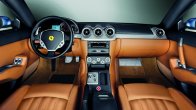 The 612 Scaglietti has the soul of a sporty berlinetta and the dimensions and design of a luxurious, surprisingly roomy Grand Tourer. Its innovative styling enhances its architecture (long wheel base, cab-rear layout, tiny overhangs) and highlights its dynamism and power. The 612 Scaglietti has the soul of a sporty berlinetta and the dimensions and design of a luxurious, surprisingly roomy Grand Tourer. Its innovative styling enhances its architecture (long wheel base, cab-rear layout, tiny overhangs) and highlights its dynamism and power.
It boasts a big, sculpted body, long aerodynamic bonnet, strong lines, and characteristic scalloped-sides - the latter a clear reference to the famous 375 MM built for Rossellini as a gift for Ingrid Bergman.
As a genuine "four-seater", the 612 Scaglietti does not compromise when it comes to occupant comfort. In fact, a host of features, ranging from the size of the doors to specially developed solutions, such as the kind of hinging system used and the easy entry system, means that all four passengers will find it easy to get into and out of at all times.
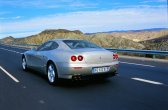 The 612 Scaglietti also offers notable legroom front and rear (it is 139 mm longer than its predecessor the 456M), plus excellent ergonomics and headroom in the body-hugging rear seats too. Even the 240-litre luggage compartment is larger and easily swallows up a six-piece luggage set designed especially for it. The 612 Scaglietti also offers notable legroom front and rear (it is 139 mm longer than its predecessor the 456M), plus excellent ergonomics and headroom in the body-hugging rear seats too. Even the 240-litre luggage compartment is larger and easily swallows up a six-piece luggage set designed especially for it.
The cabin, which can be fully personalised from the Carrozzeria Scaglietti programme on request, is dominated by aluminium and handcrafted leather. This is a sporty, sophisticated interior that reflects the 612's high tech soul. A wide range of other features guarantees exceptional driving pleasure and maximum comfort (the instrument cluster and steering wheel controls at the driver's fingertips, dual-zone climate control and a Bose Hi-End sound system, for instance).
ALUMINIUM FOR PERFORMANCE AND SAFETY
 "We started with a blank sheet on the design of the F 137, but we did have a very specific objective: we wanted to create a car that would be a break with the past in terms of its performance and roominess, one with a highly innovative character that would open the way for a whole new generation of Ferrari GTs. The decision to go for an all-aluminium chassis and body seemed completely in tune with the design as a light, rigid structure guarantees weight reduction, dynamic handling, and passenger comfort and safety all in one. We brought this advanced technology to even more sophisticated levels in the 612 Scaglietti, thanks to Ferrari's previous experience in the area and the fact that we had a centre of excellence in the Scaglietti Light Alloy Technologies complex in Modena." "We started with a blank sheet on the design of the F 137, but we did have a very specific objective: we wanted to create a car that would be a break with the past in terms of its performance and roominess, one with a highly innovative character that would open the way for a whole new generation of Ferrari GTs. The decision to go for an all-aluminium chassis and body seemed completely in tune with the design as a light, rigid structure guarantees weight reduction, dynamic handling, and passenger comfort and safety all in one. We brought this advanced technology to even more sophisticated levels in the 612 Scaglietti, thanks to Ferrari's previous experience in the area and the fact that we had a centre of excellence in the Scaglietti Light Alloy Technologies complex in Modena."
The 612 Scaglietti is the first Ferrari 12-cylinder to be built entirely from aluminium. It is no coincidence therefore that it has been named after Sergio Scaglietti, a Modenese coachbuilder who worked closely with Enzo Ferrari in the early years of his great adventure and excelled at the art of sculpting this highly unusual material (its specific weight is just a third of that of steel) into the bodies of some of the most glorious racing and road cars of the past.
 Moving a step forward from Ferrari's experience with the 360 Modena, aluminium is used both in the chassis and the body of the 612 Scaglietti. The sophisticated technologies used in the manufacture and assembly of the various structural components were developed in collaboration with American company Alcoa. They significantly cut the car's weight and improved its torsional stiffness, both of which were essential to achieving the kind of breathtaking performance that Ferrari was determined to deliver in its new model. Moving a step forward from Ferrari's experience with the 360 Modena, aluminium is used both in the chassis and the body of the 612 Scaglietti. The sophisticated technologies used in the manufacture and assembly of the various structural components were developed in collaboration with American company Alcoa. They significantly cut the car's weight and improved its torsional stiffness, both of which were essential to achieving the kind of breathtaking performance that Ferrari was determined to deliver in its new model.
The 612 Scaglietti has a SPACE FRAME CHASSIS. In fact, its structure is made up of straight aluminium extrusions (38%) connected by casts (34%) which act as joints. The sheet aluminium (28%) reinforces the structure.
 The chassis architecture also includes four large castings on which all the suspension and steering mounting points are CNC machined. This guarantees the correct dimensioning of the structure in the area of greatest stress which in turn improves the car's performance. Another two robust castings for the A-posts interface perfectly with the doors. The chassis architecture also includes four large castings on which all the suspension and steering mounting points are CNC machined. This guarantees the correct dimensioning of the structure in the area of greatest stress which in turn improves the car's performance. Another two robust castings for the A-posts interface perfectly with the doors.
The aluminium alloys used to build the 612 Scaglietti are extremely ductile during the pressing and extrusion phases and then become incredibly resistant and tough once they have been subjected to special heat treatment.
In addition to this, each casting has different mechanical characteristics in its different areas as a result of differentiated heat treatment. This means they are highly resistant at the entry points of the forces and highly ductile in the areas subject to deformation in the event of a collision.
Body
 The body too is made entirely from aluminium: both the skin and the frame are pressed sheet aluminium and are strengthened by casts and extrusions at the critical points of the door and roof. The components are assembled using different processes depending on their different functions: MIG (Metal Inert Gas) welds, spot welds, self-perforating rivets. The body too is made entirely from aluminium: both the skin and the frame are pressed sheet aluminium and are strengthened by casts and extrusions at the critical points of the door and roof. The components are assembled using different processes depending on their different functions: MIG (Metal Inert Gas) welds, spot welds, self-perforating rivets.
The result is that the 612 Scaglietti is 40% lighter than other vehicles of similar dimensions. Its structural performance is also excellent, with the complete body around 60% more efficient in terms of weight-rigidity ratio than the 456.
High static and dynamic rigidity (stiffness) combined with an initial torsional frequency mode of 47 Hz also mean a significant improvement in the car's vibration and acoustic values, which in turn enhance occupant comfort and handling.
 Chassis Costruction Chassis Costruction
The classis costruction process is carried out by Alcoa in the same section of the Ferrari-owned Scaglietti Light Alloy Technology facility in Modena in which the 360 Modena was developed and built.
After undergoing a series of extremely strict dimension and quality controls, the chassis is transferred to the bodywork assembly line, also housed in the Scaglietti facility. The line itself was designed and built specifically for the 612 and consists of 10 geometry stations. After assembly is complete, the mobile components (doors and boot) are added. These too are aluminium, of course. The final stage of the 612 Scaglietti's production process is a complete review and final controls using numerical control robots which automatically measure 450 verification points.
 The painting and assembly of the engine unit and mechanical components, as well as the interior trim work are carried out in Maranello. The painting and assembly of the engine unit and mechanical components, as well as the interior trim work are carried out in Maranello.
Safety
Naturally enough, safety is an integral part of the design. In fact, our priority with the structural capacity of the 612 Scaglietti has always been occupant protection in the case of a collision.
Unprecedented levels of robustness have been achieved with the new Ferrari's chassis and bodywork which actually significantly exceed current international standards and cover many collision configurations which have yet to be applied.
 Frontal impact crash tests were performed in line with the new offset standard with a deformable barrier at 64 km/h (8 km/h faster than the current standard). In this case, deformation of the cabin and steering wheel intrusion were very slight. The rear impact tests were performed at 80 km/h (30 km/h faster) with equally positive results. The standards we applied, in fact, will not come into force in the United States for at least another four years. Frontal impact crash tests were performed in line with the new offset standard with a deformable barrier at 64 km/h (8 km/h faster than the current standard). In this case, deformation of the cabin and steering wheel intrusion were very slight. The rear impact tests were performed at 80 km/h (30 km/h faster) with equally positive results. The standards we applied, in fact, will not come into force in the United States for at least another four years.
Particular attention was also focused on side impacts. The specially dimensioned structure of the doors, A and C-posts, are 50% more resistant to cabin intrusion in addition to the fact that the collapsibility and energy absorption of the interior trim has been optimised. The 612 Scaglietti thus offers exceptionally high occupant protection even without the use of side air bags.
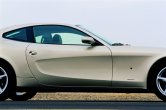 Occupant protection Occupant protection
However, occupant protection is completed by the adoption of highly innovative restraint systems. The two-stage front airbags automatically adapt their inflation rate to the severity of the collision and are designed to offer optimal protection even when the occupants are not in the correct position. Special sensors in the engine compartment use specific parameters to recognise a violent deceleration signalling that a collision may be about to happen and thus "alert" the airbag system.
Last but not least, the 612 Scaglietti offers a highly adaptable seat belts with pretensioners and load limiters as well as Isofix on the rear seats so that child seats can be used in perfect safety.
 Needless to say, the 612 Scaglietti offers an exceptionally high standard of ACTIVE SAFTEY. Thanks, of course to its unparalleled chassis characteristics, architecture, and sophisticated suspension, stability, traction control and braking systems. Needless to say, the 612 Scaglietti offers an exceptionally high standard of ACTIVE SAFTEY. Thanks, of course to its unparalleled chassis characteristics, architecture, and sophisticated suspension, stability, traction control and braking systems.
INNOVATIVE ARCHITECTURE BREEDS PURE PERFORMANCE
"When we are designing a new Ferrari, we traditionally aim even higher than ever and try to achieve previously unheard of performance. That was also our philosophy during the whole F 137 development process. Our goal was to create a front-engined, rear-wheel drive Grand Tourer with a comfortable cabin that would also offer the same kind of dynamic handling and driving pleasure as a cutting edge berlinetta. It therefore became essential to pull back and lower the car's centre of gravity and make the weight distribution highly innovative. The result was that we adopted a type of architecture that had never been used before in this category of car, giving it a mid-front engine layout and moving the gearbox into the rear in unit with the differential. It is thanks to that layout plus the power of the new 12-cylinder engine and the careful choice of the mechanical components that the 612 Scaglietti delivers the same kind of pure performance as the most thoroughbred Ferraris."
 The idea of creating a four-seater GT with all of the fiery temperament of a sporty Ferrari berlinetta was both thrilling and challenging. The idea of creating a four-seater GT with all of the fiery temperament of a sporty Ferrari berlinetta was both thrilling and challenging.
During the preparatory phase of the project, a wide range of different aspects was examined to establish the optimal solutions for a front-engined, rear wheel drive car. Aluminium technology meant that the car would be lighter and safer as well as boasting higher torsional stiffness and beautifully damped vibration. However, near-perfect weight distribution and a lower centre of gravity were also essential factors in delivering the require results in terms of dynamic performance.
Equally when it came to the aerodynamic design of the car, elements that would enhance its qualities were added to the aforementioned architecture, specifically the engine, the traditional heart and symbol of Ferrari, and the mechanical components.
 In the 612 Scaglietti, the masses are distributed to favour the front axle. Thanks in part also to the use of differently dimensioned rear and front tyres, and most particularly to the lowering of the car's centre gravity, this solution means that the 612 Scaglietti delivers the same kind of traction, cornering and braking efficiency as the company's sports cars. In the 612 Scaglietti, the masses are distributed to favour the front axle. Thanks in part also to the use of differently dimensioned rear and front tyres, and most particularly to the lowering of the car's centre gravity, this solution means that the 612 Scaglietti delivers the same kind of traction, cornering and braking efficiency as the company's sports cars.
The architecture was designed over a generous 2,950 mm wheel base. It sees the engine positioned behind the front axle (mid-front position), the gearbox in unit with the differential at the rear to ensure that the cabin can be pulled back as far as possible, and the centre of gravity 20 mm lower than the 456M. These achievements were, of course, further enhanced by the aluminium structure which makes the car significantly lighter.
 The 612 Scaglietti's 46% rear- 54% front weight distribution is unique in its category too and its kerb weight is around 1,840 kg (European version) which translates into an excellent power to weight ratio of 3.2 kg/bhp (measured on dry weight). The 612 Scaglietti's 46% rear- 54% front weight distribution is unique in its category too and its kerb weight is around 1,840 kg (European version) which translates into an excellent power to weight ratio of 3.2 kg/bhp (measured on dry weight).
The 612 Scaglietti's top speed is in excess of 315 km/h and its 0 a 100 km/h sprint time is just 4.2 seconds.
Aerodynamics
The new Ferrari 2+2's aerodynamics are the fruit of the designers' very specific decision to aim for just the right download without increasing drag. The first step in this process was to optimise the car's form, achieved using a special computer programme developed by Ferrari in collaboration with the University of Pisa. This was followed by intensive testing of a scale model in the wind tunnel to refine certain details of the design. In all, the development of the 612 Scaglietti's aerodynamics took 3,500 hours, half of which were spent in the wind tunnel.
 The bodywork styling, developed in close collaboration with Pininfarina, melds functional demands with pure aesthetics. The development of the wheelarches, engine hood, cabin and rear results in a slender, aerodynamic-looking car. The bodywork styling, developed in close collaboration with Pininfarina, melds functional demands with pure aesthetics. The development of the wheelarches, engine hood, cabin and rear results in a slender, aerodynamic-looking car.
Careful research also went into the design of the underbody of the car (double in the rear section) to ensure optimal air flows. The rear diffuser helps dissipate the heat from both the exhaust system and the gearbox oil radiator.
The results are exceptional, particularly given the fact that this is a front-engined car: Cx 0.34; Cz 0.12 (equivalent to a vertical load of 115 kg at 300 km/h).
Engine
 The 612 Scaglietti's engine is a significant development of the prestige 12-cylinder that Ferrari uses in its sports berlinettas. Specifically tailored for the new 2+2, its structure is based on the 575M Maranello's and is the absolute pinnacle of Ferrari's technological achievement. The 612 Scaglietti's engine is a significant development of the prestige 12-cylinder that Ferrari uses in its sports berlinettas. Specifically tailored for the new 2+2, its structure is based on the 575M Maranello's and is the absolute pinnacle of Ferrari's technological achievement.
The engine is a 5,748 cc 65° V12 with twin overhead cams per cylinder bank and four valves per cylinder. The engine crankcase, cylinder heads and sump are all made from light alloy. The dry sump lubrication system features the oil and water pump in unit, with two scavenge pumps and one delivery pump, two oil filters and a dedicated oil radiator. Other features include steel cylinder liners, hydraulic tappets and variable intake manifolds with an extra central plenum that improves the resonance characteristics of the fuel/air charge.
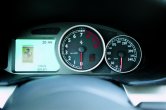 Punching out a massive 540 bhp at 7,250 rpm, the big V12 delivers a good 98 bhp more than the 5,474 cc power unit used on its predecessor, the 456M. Punching out a massive 540 bhp at 7,250 rpm, the big V12 delivers a good 98 bhp more than the 5,474 cc power unit used on its predecessor, the 456M.
With an internal code number of F133F, the new engine also features various modifications that have optimised its performance and fluid dynamics. The most important are:
- new more direct air intake tracts with separate ducts per cylinder bank from the radiator grille opening on the front bumper;
- new exhaust system geometries and volumes to cut back pressure;
- compression ratio increased to 11.2:1;
- increased discharge coefficient thanks to improved fluid dynamic characteristics of the inlet tracts and exhaust porting.
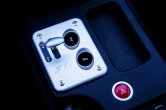 The electronic control is entrusted to a single Bosch Motronic ME7 CPU per cylinder bank which control the PFI multiplex injection, drive-by-wire. Four sensors are positioned in the engine block to prevent pinking. The electronic control is entrusted to a single Bosch Motronic ME7 CPU per cylinder bank which control the PFI multiplex injection, drive-by-wire. Four sensors are positioned in the engine block to prevent pinking.
Correct torque (60 kgm at 5.250 rpm) and power delivery along the whole power curve mean that the car performances exceptionally well at low to medium speeds too as well as with huge enthusiasm right up until the rev limiter kicks in at 7,600 rpm.
Work on the 612 Scaglietti's handling means that is smoothly responsive making it easy to control in any kind of conditions.
The integrated ignition and fuel injection system will also allows malfunctions to be spotted early on, thus guaranteeing that emission standards are complied with.
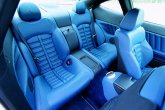 Trasmission Trasmission
The 612 Scaglietti's transaxle transmission sees the rear-mounted gearbox in unit with the differential with bevel-type final drive and limited-slip differential in the same function. This is a six-gear set-up with multi-cone synchronisers. The limited-slip differential is calibrated for 25% under acceleration and 45% on lift off to offer optimal balance between traction and stability in any condition.
Another important innovation in the 612 Scaglietti is the F1A electro-hydraulic gearbox which available in addition to the manual and is controlled using the now classic Ferrari paddle and switch on the central tunnel.
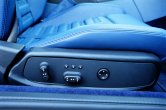 The F1A gearbox (the A stands for Automatic) is one of the sophisticated new generation Formula 1-derived electro-hydraulic systems which Ferrari now uses with great success on all of its road-going models. The software that controls it is optimised for faster, more comfortable gear shifting. The F1A gearbox (the A stands for Automatic) is one of the sophisticated new generation Formula 1-derived electro-hydraulic systems which Ferrari now uses with great success on all of its road-going models. The software that controls it is optimised for faster, more comfortable gear shifting.
Courtesy of special calibrations, this delivers both ultra-sporty and more comfortable, urban driving. The versatility of the gearbox means that the driver can choose either Manual or Automatic mode at the flick of a switch on the central tunnel. In Manual, the gears are changed using the special paddles mounted just behind the steering wheel (the right hand one to up the gears and the left hand one to move down) without any need to use the automatically controlled clutch. However, the driver just has to flick either the switch on the tunnel forward or the right-hand paddle behind the steering wheel, for the gearbox to go into fully automatic mode. In both cases (Auto or Manual), gear shifting ranges between comfortably fast and sporty, the latter courtesy of the "Sport" button on the steering wheel.
 Compared to traditional manual gearboxes, the F1A offers smoother, speedier gear shifting, improves comfort and safety, as the driver never has to raise his hands of the wheel. It also offers significantly improved performance in exceptional comfort. Compared to traditional manual gearboxes, the F1A offers smoother, speedier gear shifting, improves comfort and safety, as the driver never has to raise his hands of the wheel. It also offers significantly improved performance in exceptional comfort.
The 612 Scaglietti's CHASSIS ENGINEERING is also particularly sophisticated.
Steering
The electronic power steering has a two-way electrically adjustable steering column and "easy entry-exit" feature which makes getting into and out of the car even easier than before. The car also boasts speed-sensitive power steering.
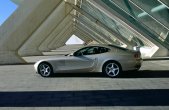 Every turn of the wheel equates to 64 mm of play on the rack and pinion steering making it very direct indeed too. In fact, it is the perfect compromise, offering enhanced sporty driving on mixed terrain and excellent control at high speeds. Every turn of the wheel equates to 64 mm of play on the rack and pinion steering making it very direct indeed too. In fact, it is the perfect compromise, offering enhanced sporty driving on mixed terrain and excellent control at high speeds.
Suspension
The active damping, variable calibration suspension system offers a high performance yet adaptive set-up. By tuning into the independent active aluminium dampers with coil springs, the system can "read" the road surface characteristics (smooth, bumpy) and instantly evaluate the movements of both the car and suspension.
 The forged aluminium double wishbones front and rear are mounted on aluminium and rubber rose joints. They also have anti-dive and anti-squat geometry which prevent the front diving under braking and the rear squatting under acceleration. The forged aluminium double wishbones front and rear are mounted on aluminium and rubber rose joints. They also have anti-dive and anti-squat geometry which prevent the front diving under braking and the rear squatting under acceleration.
The calibration of the dampers is controlled by independent software integrated with the other control systems. The system uses accelerometers to record the movements of the wheels and body, instantly adapting the calibration of the dampers to suit requirements.
The handling set-up along with the suspension geometry and weight distribution makes the bodywork very firm thus enhancing performance and sportiness. And it also offers a surprising level of comfort too.
 The ideal balance between handling and comfort for the driving style being used and the type of surface involved can be chosen at the touch a button on the steering wheel: Normal (soft calibration) and Sport (harder sportier use). The ideal balance between handling and comfort for the driving style being used and the type of surface involved can be chosen at the touch a button on the steering wheel: Normal (soft calibration) and Sport (harder sportier use).
Electronic Stability and Traction Control System (CTS)
This is also the first time that the CST electronic stability and traction control system has been used in a Ferrari. It aids the 612 Scaglietti's dynamic handling, leaving the driver a great deal of freedom but still intervening in more difficult or riskier situations.
The CST offers exceptional performance and safety in all kinds of driving conditions. The system integrates and completes the ABS and ASR functions, by also controlling the directional dynamics of the car.
 The CST can be selected either for normal or sporty driving (Normal and Sport) or deactiveated using a special steering wheel-mounted button. The CST can be selected either for normal or sporty driving (Normal and Sport) or deactiveated using a special steering wheel-mounted button.
Braking System
The 612 Scaglietti's braking system is particularly responsive and resistant to fading, making it the perfect partner to the 2+2's blistering performance. It consists of large diameter, drilled, ventilated discs (345 mm front and 330 mm rear) with four-pot callipers. The brake servo includes twin membranes (one 8" and one 9") and an integral pump, and incorporates special venturis in the connection with the intake plenums that increase the depression inside the servo for greater immediacy and power. The ABS system is a Bosch 5.7 generation.
 Combined with the 612's impressive weight distribution and the specially dimensioned tyres, it delivers excellent braking, confirmed by standard Ferrari track stress tests. Combined with the 612's impressive weight distribution and the specially dimensioned tyres, it delivers excellent braking, confirmed by standard Ferrari track stress tests.
Wheels
The 612 Scaglietti's wheels are a highly efficient compromise between performance and weight reduction too. They boast different diameters for an improved performance-comfort ratio (18" front, 19" rear). Also they are cast in aluminium and a roller-coater is used on the channel for optimal distribution of the material (a sophisticated process that optimises metallurgical qualities of the wheel). This results in a 10% reduction in weight over wheels of similar dimensions and design.
 The 612 Scaglietti's big tyres (245/45/18 e 285/40/19) are the result of a great deal of hard work on the Fiorano circuit and on out on the road, so that they guarantee just the right level of comfort even in sportier driving conditions. The 612 Scaglietti's big tyres (245/45/18 e 285/40/19) are the result of a great deal of hard work on the Fiorano circuit and on out on the road, so that they guarantee just the right level of comfort even in sportier driving conditions.
The Tyre Pressure Monitoring System (TRMS) also alerts the driver to changes in the tyre pressure via a display.
PININFARINA STYLING, EXCELLENT ONBOARD COMFORT AND SPACE
"The F 137 design developed around the concept of a GT model that, unlike the 456M, would be more than just a 2+2. While the use of light alloys and the choice of a specific kind of architecture deliver pure thoroughbred Ferrari performance, a carefully designed interior also means that the 612 Scaglietti offers excellent onboard comfort and space. The layout of the cabin and the relevant components combined with ergonomic research made it possible for us to fit four seats into a roomy, elegant yet exceptionally functional space. The car's Pininfarina styling, developed to suit its structural layout, is designed to epitomise the car's dynamism and performance. The comfortably roomy interior, which comes courtesy of the very efficient chassis, will mean that the occupants get to experience the clean, thrilling roar of the Ferrari V12."
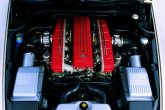 The 612 Scaglietti is by definition a car designed for long journeys: it will eat up the miles on motorways, mixed terrain and even urban areas. This is an exciting car to drive, technologically sophisticated yet nimble and wonderfully comfortable to use in day-to-day situations. The 612 Scaglietti is by definition a car designed for long journeys: it will eat up the miles on motorways, mixed terrain and even urban areas. This is an exciting car to drive, technologically sophisticated yet nimble and wonderfully comfortable to use in day-to-day situations.
Even getting in and out of the car is no longer awkward for rear passengers. Once aboard, they can experience the 612 Scaglietti's stunning performance in a sophisticated, sports car style interior, from the comfort of soft, body-hugging seats that offer exceptional legroom and headroom too.
Roominess
 This is because, beneath its elegant, aerodynamic exterior, the 612 Scaglietti is surprisingly roomy and comfortable, an effect achieved thanks to careful design of the car's structural architecture, wheel base, dimensions (particularly its length), the position of the cabin and the design of its various components from the doors to the seats, and, of course, ergonomics. This is because, beneath its elegant, aerodynamic exterior, the 612 Scaglietti is surprisingly roomy and comfortable, an effect achieved thanks to careful design of the car's structural architecture, wheel base, dimensions (particularly its length), the position of the cabin and the design of its various components from the doors to the seats, and, of course, ergonomics.
These factors plus the positioning of the 108-litre fuel tank on the rear axle have turned the 612 Scaglietti into a truly exceptional car. In fact, the new Ferrari offers much better legroom and headroom than any other traditional 2+2, offering equal onboard comfort to its four occupants.
For instance, rear passengers now enjoy 70 mm more headroom than in the 456M and the backrest has been modified 12 degrees to improve posture and comfort too.
 Getting into and out of the 612 Scaglietti is easy for people of all sizes also, thanks to the special door hinges that ensure that the doors open over 150 mm wider than the 456M's; the door frame profiles; the electric "easy entry-exit" switch which lowers the front seat and its headrest and slides it forward while the steering wheel tilts. Getting into and out of the 612 Scaglietti is easy for people of all sizes also, thanks to the special door hinges that ensure that the doors open over 150 mm wider than the 456M's; the door frame profiles; the electric "easy entry-exit" switch which lowers the front seat and its headrest and slides it forward while the steering wheel tilts.
The driver and passenger seats are also wonderfully adjustable at the touch of a button to allow them to find the most comfortable position: the seats are adjustable for height, tilt, backrest angle and lumbar support. They can also slide forward and the headrest can be raised. There are also three memory settings which are linked into the exterior mirrors (tuck-in, demister and automatic modification for reversing) and the steering wheel position. For even greater comfort the seatbelts are "on board", i.e. hooked on to the seat structure beside the headrest.
 Design Design
The design of the 612 Scaglietti fully expresses the model's new values. In fact, Ferrari made a conceptual choice with Pininfarina to ensure that the four-seater would be a genuine departure from previous Grand Tourer models. It also made a technical decision that the bodywork would have to clothe a completely innovative structural layout. The 612 Scaglietti translates this approach into wonderfully aerodynamic lines. It is softly and elegantly aggressive, sculpted to express the powerful personality of a prestigious high performance, surprisingly roomy car.
Its strong lines run over full, solid surfaces, creating sensual forms that still have the tension of a true thoroughbred.
 The long scallops on the 612 Scaglietti's flanks lend it character and aerodynamic elegance too. These are borrowed from another famous Ferrari, the 375 MM ordered by Roberto Rossellini as a gift for actress Ingrid Bergman. The choice of the scalloped sides was far from casual as the only example ever built of the 375 MM was shown at the Paris Show in 1954: it was a truly magnificent model that married high performance engineering with a sophisticated, thoroughbred body. The long scallops on the 612 Scaglietti's flanks lend it character and aerodynamic elegance too. These are borrowed from another famous Ferrari, the 375 MM ordered by Roberto Rossellini as a gift for actress Ingrid Bergman. The choice of the scalloped sides was far from casual as the only example ever built of the 375 MM was shown at the Paris Show in 1954: it was a truly magnificent model that married high performance engineering with a sophisticated, thoroughbred body.
The front wheel arches are very long with a shorter overhang while the rear ones are prominent and muscular to support the C-post. A dihedral enhances the line along the whole upper side. The projector headlights have transparent covers too. The 612 Scaglietti's twin Xenon projector headlights also offer a beam that is far superior to traditional halogen lights.
 The traditional Ferrari air intake is given an original twist with the wheelarches protruding slightly further than the bonnet. The latter, thanks to a low, pulled-back engine, is set deep between the wheelarches which are the car's dominant volumes and give it an aerodynamic flourish accentuated by the crisp aluminium crease. The traditional Ferrari air intake is given an original twist with the wheelarches protruding slightly further than the bonnet. The latter, thanks to a low, pulled-back engine, is set deep between the wheelarches which are the car's dominant volumes and give it an aerodynamic flourish accentuated by the crisp aluminium crease.
The rear section is big and solid-looking with the classic high tail lights. This design meets the aerodynamic demands of the slender profile that increases downforce. Especially for the 612 Scaglietti, Ferrari has added two new shades to its colour range: "Rubino Micalizzato" and "Blu Mirabeau".
Interior
 The 612 Scaglietti boasts a wonderfully sophisticated sporty interior that reflects its all-aluminium structure and advanced technologies. The pressed or solid aluminium used for the interior becomes a decorative element: it's there on the desk, the air vent block, the climate control buttons, the F1A paddles, the pedals and passenger treadplate. The 612 Scaglietti boasts a wonderfully sophisticated sporty interior that reflects its all-aluminium structure and advanced technologies. The pressed or solid aluminium used for the interior becomes a decorative element: it's there on the desk, the air vent block, the climate control buttons, the F1A paddles, the pedals and passenger treadplate.
The dashboard offers the driver a cluster of analogue and digital instruments. Alongside the big rev counter is the five inch multifunctional display with three modes: base, trip computer and tyre pressure.
The main driving controls are all mounted on the steering wheel too. The dynamic driving buttons are on the right (activate/deactivate Sport and CST) and the display buttons are on the left.
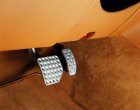 The cabin's functionality is highlighted by the use of great swathes of beautifully crafted leather which is hand-stitches and discreetly but incredibly comfortably padded. The same leather used for the seats is also used for the door pockets handles, and knee rests too. The cabin's functionality is highlighted by the use of great swathes of beautifully crafted leather which is hand-stitches and discreetly but incredibly comfortably padded. The same leather used for the seats is also used for the door pockets handles, and knee rests too.
This is an exclusive, sporty cabin in which comfort is assured by the climate control and audio systems. The former is dual-zone and automatically regulates in-car temperature, humidity and ventilation levels. Aluminium controls on the central console allow both driver and front passenger to set the air flow strengths and desired temperature (17 to a 27 degrees centigrade). The vent clusters (on the dash, doors and central tunnel) guarantee excellent comfort levels to all of the occupants.
 The sound system includes a radio, CD player (a compartment on the dash holds four CDs while a further six are contained in the CD loader in the boot) and a six-channel digital unit, developed especially for the 612 Scaglietti by Bose®. Cutting edge in the automobile sector, the system offers the same kind of audio quality of a top flight home entertainment centre. The system boasts three twiddlers on the dash, two woofers and two tweeters on the sides of the rear seats, one amplified 100 W bass box in the front and one 100 W amplified subwoofer (diameter 250 mm) at head-level. A microphone in the roof lamp controls the Audio Pilot - which automatically equalises the sound if it senses other background noise or disturbance. Other features offered as standard with the 612 Scaglietti include: a dusk sensor switch which automatically turns on the headlights when activated, a rain sensor for automatic windshield wiper actioning; an antitheft system with alarm (the immobiliser is controlled by inserting the key which has an inbuilt transponder). The sound system includes a radio, CD player (a compartment on the dash holds four CDs while a further six are contained in the CD loader in the boot) and a six-channel digital unit, developed especially for the 612 Scaglietti by Bose®. Cutting edge in the automobile sector, the system offers the same kind of audio quality of a top flight home entertainment centre. The system boasts three twiddlers on the dash, two woofers and two tweeters on the sides of the rear seats, one amplified 100 W bass box in the front and one 100 W amplified subwoofer (diameter 250 mm) at head-level. A microphone in the roof lamp controls the Audio Pilot - which automatically equalises the sound if it senses other background noise or disturbance. Other features offered as standard with the 612 Scaglietti include: a dusk sensor switch which automatically turns on the headlights when activated, a rain sensor for automatic windshield wiper actioning; an antitheft system with alarm (the immobiliser is controlled by inserting the key which has an inbuilt transponder).
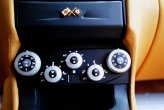 The luggage compartment is bigger too: 240 litres as opposed to the 456M's 190 and the spare tyre cubby hole can be used for extra luggage too. The luggage compartment is bigger too: 240 litres as opposed to the 456M's 190 and the spare tyre cubby hole can be used for extra luggage too.
"Carrozzeria Scaglietti" personalisation programme
The Carrozzeria Scaglietti Personalisation Programme allows clients, in typical Ferrari style, to choose the styling flourishes, finishes and accessories for the car to suit their own tastes and needs, adding a truly "personal touch" to their 612 Scaglietti. This forges a special relationship between Ferrari's clients and their cars. In fact, they can even go so far as to have a personalised silver registration plate.
 Three specific areas are covered by the programme: Exterior and Colours; Interior and Materials; Equipment and Travel. Three specific areas are covered by the programme: Exterior and Colours; Interior and Materials; Equipment and Travel.
With Exterior and Colours, for instance, clients can choose a body paint that is not in the range or a colour matching a sample. They can also put "Scuderia Ferrari" shields on the fenders or have red, yellow or aluminium grey brake calipers. Other options include 19'' modular five spoke rims wheel with titanium screws (designed by Pininfarina) or a version polished using an exclusive system to enhance its shape and volumes.
There is a plethora of personalisation options for the cabin too. Clients can choose, amongst other things, the colours of the area above the dash or those lower down in the interior, order heated front seats, special finishes or Daytona-style upholstery as featured on the Ferrari berlinettas cars of the past.
 The Travel section offers a radio-satellite navigation system that includes a radio, a CD player and navigator in a single unit, integrated phone devices including Bluetooth technology (the cell phone and stereo unit can talk to each other cordlessly). Parking sensors are also available. The Travel section offers a radio-satellite navigation system that includes a radio, a CD player and navigator in a single unit, integrated phone devices including Bluetooth technology (the cell phone and stereo unit can talk to each other cordlessly). Parking sensors are also available.
A special repair and wheel inflation kit comes with the 612 Scaglietti as standard. Upon request 19" spare and "run flat" tyres are available. The latter, which can travel 120 km at zero pressure at speeds of up to 80 km/h, have a reinforced section that stops the structure and profile collapsing.
Also available to make life aboard even more luxurious is the exclusive six-piece Ferrari luggage set specially designed by Pininfarina for the luggage compartment.
[source: newspress.co.uk & http://car.kak.net]

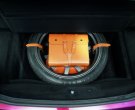

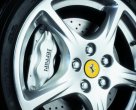
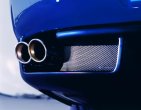








|
|
 A genuine four-seater Ferrari, the all-aluminium 612 Scaglietti is
the result of an avant-garde design that guarantees the pure, thoroughbred
performance demanded by Ferraristi combined with uncompromising driver
and passenger comfort. The new 2+2 model signals a genuine break with
the past. Ferrari has changed the rules of the game with the 612 Scaglietti
to suit the tastes and needs of a highly sophisticated clientele which
now demands elegance and dynamic comfort as well as blistering performance.
The 612 Scaglietti is very much a third millennium product, offering
a whole new generation of technologies compared to the 2+2 it replaces.
In fact, it isn't really a 2+2 at all but more a genuine roomy two-door
four-seater that offers its occupants a comfortable, pleasant ride
in any driving conditions.
A genuine four-seater Ferrari, the all-aluminium 612 Scaglietti is
the result of an avant-garde design that guarantees the pure, thoroughbred
performance demanded by Ferraristi combined with uncompromising driver
and passenger comfort. The new 2+2 model signals a genuine break with
the past. Ferrari has changed the rules of the game with the 612 Scaglietti
to suit the tastes and needs of a highly sophisticated clientele which
now demands elegance and dynamic comfort as well as blistering performance.
The 612 Scaglietti is very much a third millennium product, offering
a whole new generation of technologies compared to the 2+2 it replaces.
In fact, it isn't really a 2+2 at all but more a genuine roomy two-door
four-seater that offers its occupants a comfortable, pleasant ride
in any driving conditions.























































